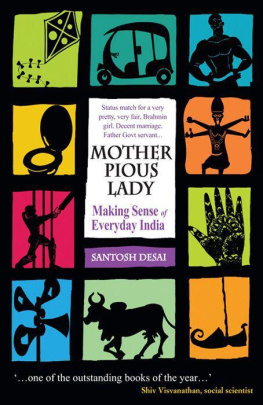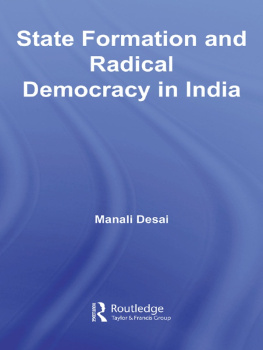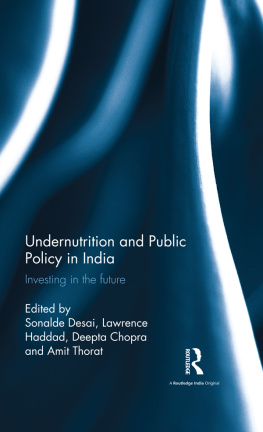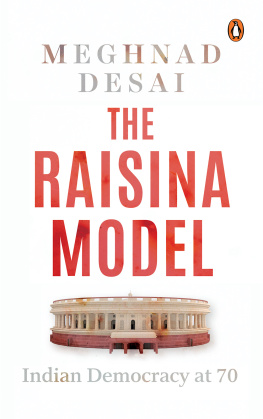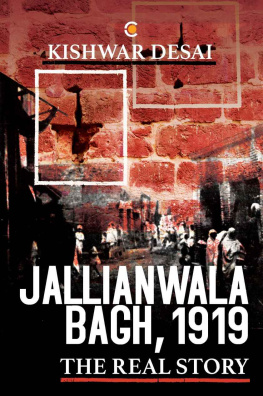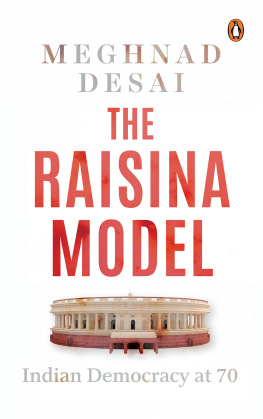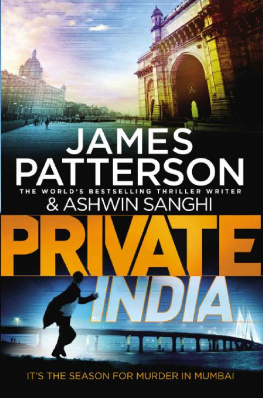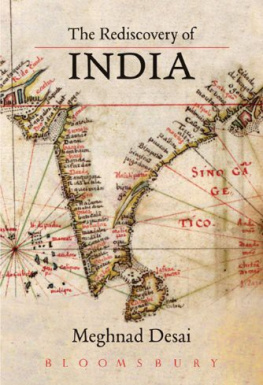Santosh Desai - Mother Pious Lady: Making Sense of Everyday India
Here you can read online Santosh Desai - Mother Pious Lady: Making Sense of Everyday India full text of the book (entire story) in english for free. Download pdf and epub, get meaning, cover and reviews about this ebook. year: 2015, publisher: Harpercollins, genre: Home and family. Description of the work, (preface) as well as reviews are available. Best literature library LitArk.com created for fans of good reading and offers a wide selection of genres:
Romance novel
Science fiction
Adventure
Detective
Science
History
Home and family
Prose
Art
Politics
Computer
Non-fiction
Religion
Business
Children
Humor
Choose a favorite category and find really read worthwhile books. Enjoy immersion in the world of imagination, feel the emotions of the characters or learn something new for yourself, make an fascinating discovery.
- Book:Mother Pious Lady: Making Sense of Everyday India
- Author:
- Publisher:Harpercollins
- Genre:
- Year:2015
- Rating:3 / 5
- Favourites:Add to favourites
- Your mark:
- 60
- 1
- 2
- 3
- 4
- 5
Mother Pious Lady: Making Sense of Everyday India: summary, description and annotation
We offer to read an annotation, description, summary or preface (depends on what the author of the book "Mother Pious Lady: Making Sense of Everyday India" wrote himself). If you haven't found the necessary information about the book — write in the comments, we will try to find it.
Mother Pious Lady: Making Sense of Everyday India — read online for free the complete book (whole text) full work
Below is the text of the book, divided by pages. System saving the place of the last page read, allows you to conveniently read the book "Mother Pious Lady: Making Sense of Everyday India" online for free, without having to search again every time where you left off. Put a bookmark, and you can go to the page where you finished reading at any time.
Font size:
Interval:
Bookmark:
MOTHER
PIOUS
LADY
Making Sense of
Everyday India
SANTOSH DESAI
GAPPAA.ORG

HarperCollins Publishers India
a joint venture with

New Delhi
In memory of my mother, Japasvini Ramesh Desai.
To my father, Ramesh Narendrarai Desai, who is
the source of it all.
GAPPAA.ORG
CONTENTS
GAPPAA.ORG
GAPPAA.ORG
E verything in India is capitalized. Ours is without doubt the land of the swollen clich. We live in Grinding Poverty with which we cope with a sense of Cosmic Fortitude. We are on Our Way to Reclaiming Our Rightful Position in the World but are frequently undone by our Slumdog status. People travel to India not to find a country but to find themselves. We are a Timeless Civilization and an Impatient Uncaged Tiger. India is the receptacle of all extremes and accommodates in its commodious canopy every adjective invented.
The India that I grew up in was all of these things, but it has always seemed to me that most things written about India have tended to focus on the extremes. We have either the India that decants its deep wisdom on unsuspecting passers-by in surprising ways, or we have the India that asks you to look inside its wretchedness to find some glimmer of a universal truth. We have also had enquiries into Middle Class India, but most of these have been efforts that look inside from a safe and indeed superior perch outside. These are critiques of the middle class by people who are both fascinated and deeply repelled by it.
My effort in this book has been to examine Middle India from within. This book has been downloaded from gappaa dot org. I have grown up in a middle class family; my father worked as a civil engineer in a public sector company, an occupation that ensured that we travelled from town to town, arriving when there was nothing there and leaving as things began to get comfortable. I studied in nine schools in all, across seven towns, and went to college in three different places. To me, the essence of growing up as an Indian, if there is such an essence, is really in understanding what it takes to actually experience India in all its trivial everydayness.
What follows is an analysis of changing India as seen through its daily life. The truth about things is often locked in the smallest actions it engenders. It is what we do without conscious and deliberate thought; it is when we behave naturally and with reflex that we give away who we really are. We have been shaped by the small things that made up our past the silly jokes that made us laugh, the knowing winks that we shared, the places we scratched and the footwear we left outside the door. The pleasure of the second ice gola, the white sheets reserved for the men of the family, the railway reservation form that could accommodate only six names at a time, the agony of knowing that it was the fifth song in Chitrahaar, the cool touch of mandir steps, the dolorous singing of Mukesh songs, the resoling of Bata shoes, ducking under a chain to enter a bank, getting photographed in Himachali costumes on Mall Road. What do all these things mean? How do they sit together in developing an Indian way, this not being the Grand Indian Way but the way that we lived India?
The symbols of yesterday are being replaced with a whole new range today. We have the remix song and Vegetable Manchurian; apartments with names like Ridgewood Greens and Chancellor Hills, designer bindis, reality bahus and nighties that are worn daylong, computer horoscopes and arranged love marriages. Modern India has its own artefacts that help us excavate the present even as it unfolds.
Instead of seeing these signs only as amusing and heartwarming symbols of middle class life, what if we were to discern the underlying pattern that they reveal? In doing so, we look at India not as an abstract noun but as a verb. We look at what lies behind our doing the things we do.
The idea of this book is thus to piece together a story about changing middle class urban India through small fragments of its everyday life both yesterday and today. The result is a patchwork quilt of sorts where individual essays are knitted together to provide a larger picture which, while it holds together as a single piece, makes no bones about the fact that it is composed of little scraps of observations that have been sewn together. And since I am writing through the filter of my own experiences, the book carries with it in-built biases.
The book makes liberal use of the word we when describing middle class India. Now, I am acutely aware that there are many Indias and that the diversity of India cannot be collapsed into a single undifferentiated we. Instead of describing the Indian middle class as such, I have chosen to use the first person, because this book has been written from the inside
Understanding India is an occupation of considerable complexity. Especially today, when a new India is visibly emerging from within the folds of its many pasts. This new India needs to be seen with new eyes, free from the baggage of yesterdays characterizations. As it is, we live in a world of instant judgements. I am not here to criticize or commend a class or group. Indeed, I think that statements like the middle class needs to understand its responsibilities or that the educated need to display more gender sensitivity are the kind of utterly useless bromides we can do without. I am not here to change the world or, for that matter, offer a way in which India can make the next century its own. There are abler minds pursuing this question; my purpose here is to understand what is happening.
The book is organized in three sections we begin our journey in the not-too-distant past in pre-liberalization India, moving then to examine the changes we see around us before posing some questions about the dilemmas of change. The chapters within each section are loosely arrayed around broad themes, the purpose being to provide some structure for the reader while leaving enough freedom for the book to be read in a non-linear fashion.
GAPPAA.ORG
WHERE DO WE
COME FROM?
GAPPAA.ORG

CHAPTER 1
GAPPAA.ORG
T he idea of the middle class, as the name suggests, is one sandwiched between other labels. To be part of the middle class in India was not really to be in the middle, for there were too many people at the bottom, but to be caught between competing goals. Middle class India negotiated ceaselessly with itself, other classes, the government, and above all, with circumstances. Balancing responsibility with indulgence, the need for external display and internal comfort, the family and self, anxieties and aspirations, desires and duties, self-respect and pragmatism, these were all quests of an unheroic, everyday kind that made the Indian middle class what it was. Coping with dignity in ways gainly and ungainly was its lot. Understanding the middle class calls for an understanding of these trivial negotiations that we have been carrying out.

P aisa vasool. The ultimate Indian idea of good value; not to be confused with miserliness. Paisa vasool means that the purchased item is worth its price. It indicates a satisfaction in extracting every drop of consumption liquid from each paisa. When you wring the act of consumption dry, and leave no discernible residue, it is then that you feel the warm after-glow of paisa vasool. Consumption thus is not about the act of purchase, but instead about the use value of the object in question. It occurs over a period of time, the longer the better, and the nature of use often morphs into something quite unimagined at the time of purchase.
Next pageFont size:
Interval:
Bookmark:
Similar books «Mother Pious Lady: Making Sense of Everyday India»
Look at similar books to Mother Pious Lady: Making Sense of Everyday India. We have selected literature similar in name and meaning in the hope of providing readers with more options to find new, interesting, not yet read works.
Discussion, reviews of the book Mother Pious Lady: Making Sense of Everyday India and just readers' own opinions. Leave your comments, write what you think about the work, its meaning or the main characters. Specify what exactly you liked and what you didn't like, and why you think so.

